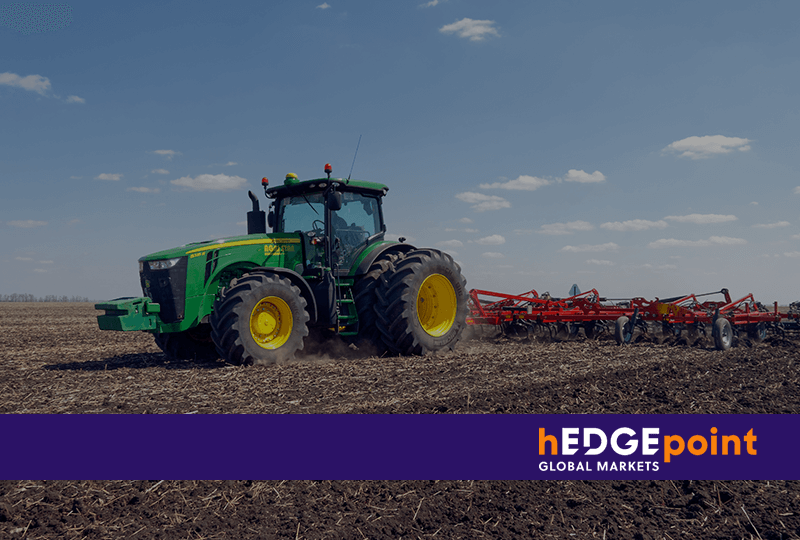
Producers in South America are starting to plant their 23/24 soybean and corn crops while global markets are carefully observing these movements. After all

Producers in South America are starting to plant their 23/24 soybean and corn crops while global markets are carefully observing these movements. After all, Brazil represented 42% of the world’s soybean production in the 22/23 harvest.
In turn, Argentina produced 34 million tons of corn last season, despite the adverse conditions. Even so, it maintained its position as the second major producer on the continent, behind only Brazil.
We’re at the beginning of the latest harvest, and the effects of the climatic phenomenon called El Niño can already be felt. In this scenario, it’s essential to know what hedging tools are available to better manage risks and protect your business from volatility.
With this in mind, we’ve invited the following hEDGEpoint experts to share their insightful perspectives regarding the continent’s grain market:
Keep reading to find out more about the expectations of the global commodity chain!
In Brazil, there’s a specific situation that deserves to be highlighted: the “sanitary void.” This is the continuous period of at least 90 days during which plants of a given crop cannot be planted or cultivated, regardless of their stage of development.
It’s a crucial phytosanitary measure used to control the emergence of possible pests and diseases, which minimizes negative impacts during the following harvest. Each state has a specific sanitary void period, which must be followed according to the recommendations of the Ministry of Agriculture, Livestock, and Supplies (See map).

“After a few years of planting delays, producers asked state governments to bring forward the end of the sanitary void period. This was due to the fear that the weather would prevent planting further down the road. The main consequence of a soybean planting delay is that the second harvest starts to develop during the drier months. This situation can become a problem,” Pedro Schicchi explains.
In relation to grain production, the prospects are for both an increase in the area and productivity of crops such as corn and soybeans. Although producers are experiencing reduced margins due to falling sales prices and rising input costs, projections are still optimistic. In the case of soybeans, there are signs of an expansion of up to 1.5 million hectares in the planting area.
“The largest harvest in history is expected, with a record of around 160 to 165 million tons. Expectations are very good, with favorable weather in Mato Grosso (MT), the main soy-producing state, for the next 15 days,” Marcelo Lacerda added.
After Argentina recently faced one of the worst harvests in its history, many producers will be more cautious when making decisions. However, for the 23/24 grain cycle, the country should recover due to the end of the extreme drought.
In the case of Argentine soybeans, there’s an indication of an increase in the sowing area, which could reach around 17 million hectares. The forecast is for a 130% increase in total soybean production compared to the 22/23 harvest. Corn also continues to enjoy good prospects with El Niño favoring its development.

“The corn area is being planted earlier, with the promise of better rains. It’s important to remember that Argentine corn has good opportunities in international markets, as its harvest occurs in March and April, before the Brazilian one,” Sol Arcidiácono said.
Thus, Argentine producers should prioritize the use of earlier seeds, avoiding competition with the second Brazilian harvest, which can put pressure on prices. The total area planted with corn could total 7.9 million hectares, 3% more than in the previous cycle.
For Arcidiácono, Paraguay, and Uruguay are also relevant in global grain markets, and we need to closely monitor the scenarios in these regions.
“These countries welcome the prospect of excellent rainfall, behaving in a similar way to the south of Brazil. There’s optimism for the development of sowing in both, driven by the positive effects of El Niño,” Sol explained.
Paraguay should stand out with a 13.6% increase in soybean production compared to the previous cycle, reaching 10 million tons, according to projections by the United States Department of Agriculture (USDA).
With more favorable weather conditions, Uruguay should recover from the drought in the previous season, marked by the third consecutive year of La Niña effects. Rainfall during the 22/23 season was considerably below average, resulting in problems for the country’s grain crops.
The 23/24 grain season will be influenced by El Niño. The phenomenon is characterized by the abnormal warming of Pacific Ocean waters, modifying wind patterns, and altering the distribution of humidity and heat on the planet.

Current forecasts indicate that El Niño should gain intensity and remain at least until next year, bringing greater amounts of rain to the grain-producing regions of South America mentioned above, Thais Italiani explained.
“El Niño is appearing later this year. It will be intense in the south of Brazil and Argentina, bringing a lot of rain. In the north of Brazil, the climate is dry. We need to carefully observe how this phenomenon will affect Mato Grosso,” she continued.
For South America, El Niño tends to bring more rain in general and is beneficial for the development of crops in Argentina, Paraguay, and Uruguay. The greater humidity expected in the south of the continent could cause a jump in the harvest in Rio Grande do Sul and a large harvest in Paraná state.
If these prospects are fulfilled, South American countries could account for something close to two-thirds of global soybean production in 23/24. Fears focus on possible below-average rains in the center-west and southeast regions of Brazil starting in November, in addition to heavier rains at the time of the soybean harvest.
“There’s a fear that it will rain a lot during the soybean harvest season between January and February, delaying delivery and damaging the quality of the product. If this happens, there’s a chance of a negative scenario for the corn area because the crop fits into this planting window,” clarified Marcelo Lacerda.
Read our exclusive content about the effects of El Niño on commodity markets here.

With the next grain harvest clearly impacted by El Niño, commodity markets could become extremely volatile. It’s vital to have risk management strategies in place to protect yourself from resulting price variations.
“The current climate in South America contributes to market volatility. It’s an opportune moment for producers and other agents in the chain to start putting well-planned financial strategies into practice,” Marcelo Lacerda elucidated.
At hEDGEpoint, we harness effective hedging products that contribute to well-informed decision making related to all these opportunities. We put together the extensive knowledge of our professionals who deeply understand this sector and its many variables.
Talk to us today to find out how to use hedging instruments to your advantage.

Rua Funchal, 418, 18º andar - Vila Olímpia São Paulo, SP, Brasil
Contato
(00) 99999-8888 example@mail.com
Section
Home
O que Fazemos
Mercado
Quem Somos
HUB
Blog
Esta página foi preparada pela Hedgepoint Schweiz AG e suas afiliadas (“Hedgepoint”) exclusivamente para fins informativos e instrutivos, sem o objetivo de estabelecer obrigações ou compromissos com terceiros, nem de promover uma oferta ou solicitação de oferta de venda ou compra de quaisquer valores mobiliários, commodity interests ou produtos de investimento.
A Hedgepoint e suas associadas renunciam expressamente a qualquer uso das informações contidas neste documento que direta ou indiretamente resulte em danos ou prejuízos de qualquer natureza. As informações são obtidas de fontes que acreditamos serem confiáveis, mas não garantimos a atualidade ou precisão dessas informações.
O trading de commodity interests, como futuros, opções e swaps, envolve um risco substancial de perda e pode não ser adequado para todos os investidores. Você deve considerar cuidadosamente se esse tipo de negociação é adequado para você, levando em conta sua situação financeira. O desempenho passado não é necessariamente indicativo de resultados futuros. Os clientes devem confiar em seu próprio julgamento independente e/ou consultores antes de realizar qualquer transação.
A Hedgepoint não fornece consultoria jurídica, tributária ou contábil, sendo de sua responsabilidade buscar essas orientações separadamente.
A Hedgepoint Schweiz AG está organizada, constituída e existente sob as leis da Suíça, é afiliada à ARIF, a Associação Romande des Intermédiaires Financiers, que é uma Organização de Autorregulação autorizada pela FINMA. A Hedgepoint Commodities LLC está organizada, constituída e existente sob as leis dos Estados Unidos, sendo autorizada e regulada pela Commodity Futures Trading Commission (CFTC) e é membro da National Futures Association (NFA), atuando como Introducing Broker e Commodity Trading Advisor. A Hedgepoint Global Markets Limited é regulada pela Dubai Financial Services Authority. O conteúdo é direcionado a Clientes Profissionais e não a Clientes de Varejo. A Hedgepoint Global Markets PTE. Ltd está organizada, constituída e existente sob as leis de Singapura, isenta de obter uma licença de serviços financeiros conforme o Segundo Anexo do Securities and Futures (Licensing and Conduct of Business) Act, pela Monetary Authority of Singapore (MAS). A Hedgepoint Global Markets DTVM Ltda. é autorizada e regulada no Brasil pelo Banco Central do Brasil (BCB) e pela Comissão de Valores Mobiliários (CVM). A Hedgepoint Serviços Ltda. está organizada, constituída e existente sob as leis do Brasil. A Hedgepoint Global Markets S.A. está organizada, constituída e existente sob as leis do Uruguai.
Em caso de dúvidas não resolvidas no primeiro contato com o atendimento ao cliente (client.services@hedgepointglobal.com), entre em contato com o canal de ouvidoria interna (ombudsman@hedgepointglobal.com – global ou ouvidoria@hedgepointglobal.com – apenas Brasil) ou ligue para 0800-8788408 (apenas Brasil).
Integridade, ética e transparência são valores que guiam nossa cultura. Para fortalecer ainda mais nossas práticas, a Hedgepoint possui um canal de denúncias para colaboradores e terceiros via e-mail ethicline@hedgepointglobal.com ou pelo formulário Ethic Line – Hedgepoint Global Markets.
Nota de segurança: Todos os contatos com clientes e parceiros são realizados exclusivamente por meio do nosso domínio @hedgepointglobal.com. Não aceite informações, boletos, extratos ou solicitações de outros domínios e preste atenção especial a variações em letras ou grafias, pois podem indicar uma situação fraudulenta.
“Hedgepoint” e o logotipo “Hedgepoint” são marcas de uso exclusivo da Hedgepoint e/ou de suas afiliadas. O uso ou reprodução é proibido, a menos que expressamente autorizado pela HedgePoint.
Além disso, o uso de outras marcas neste documento foi autorizado apenas para fins de identificação. Isso, portanto, não implica quaisquer direitos da HedgePoint sobre essas marcas ou implica endosso, associação ou aprovação pelos proprietários dessas marcas com a Hedgepoint ou suas afiliadas.
aA Hedgepoint Global Markets é correspondente cambial do Ebury Banco de Câmbio, de acordo com a resolução CMN Nº 4.935, DE 29 DE JULHO DE 2021, Artigo 14 do Banco Central do Brasil (BACEN).
Para mais informações sobre nosso parceiro, serviços disponíveis, atendimento e ouvidoria, acesse o link a seguir: https://br.ebury.com/